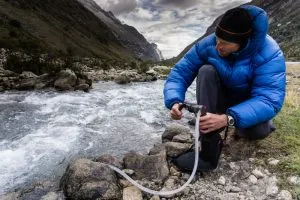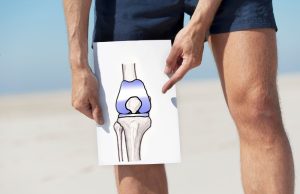Hiking With A Hernia (Safety Guide)

Hiking can sometimes require a lot out of you physically, and if you’re not in the best physical state, it can potentially put you in harm’s way.
I have a few family members who suffered through hernias, and I thought I had one recently. Hernias can be a potentially life-threatening health condition when not monitored or cared for properly. If you have a hernia or are concerned you may have one; you might be wondering if it’s safe to hike with one.
Your safety hiking with a hernia is dependent on the intensity of your hike, which we will explore in more detail in this article.
Quick Links
What Is a Hernia?
A hernia is when tissue or part of an organ, such as the loop of an intestine, pushes its way through a weak spot of connective tissue in a muscle wall. When this happens, it can cause a bulge that can cause a tremendous amount of discomfort if left untreated.
Hernias occur most commonly around the belly, groin, and upper thigh area. They can also occur in areas where you have had an incision from previous surgery.
There are actually several different types of hernias. The most common types of hernias are Inguinal, Hiatal, Umbilical, and Femoral. Let’s discuss.
Inguinal
An inguinal hernia is the most common type of hernia one can get. This type of hernia occurs when tissue, such as part of the intestine, protrudes through a weak point in the abdominal wall. The resulting bulge can be painful, especially when you cough, bend over or lift a heavy object.
An inguinal hernia isn’t necessarily dangerous, but will not improve on its own. If left untreated, an inguinal hernia can lead to life-threatening complications. Medical intervention is going to be the best way to treat this hernia, especially if it is causing pain or increasing in size.
Hiatal
A hiatal hernia is most common in people over the age of 50. This type of hernia occurs when part of the stomach pushes up into the chest cavity through an opening in the diaphragm
Smaller Hiatal hernias usually don’t cause problems, and you might not even be aware you have one unless your doctor comes across it while checking for another condition.
This type of hernia is known to bring chest pain, heartburn, and difficulty swallowing. Self-care measures and medications can usually relieve these symptoms, but a very large hiatal hernia will likely require surgery.
Umbilical
An umbilical hernia typically occurs in newborn babies but has the possibility of occurring in adulthood. This type of hernia occurs when fatty tissue or part of the intestine pushes through the abdomen near your belly button.
When they occur in children, umbilical hernias are generally harmless; however, when they occur in adults, surgical intervention is almost always needed.
Femoral
A femoral hernia typically occurs when fatty tissue or a part of your bowel pokes through into your groin at the top of your inner thigh.
A femoral hernia occurs when fatty tissue or part of your bowel protrudes through connective tissue into your groin area or the top of your inner thigh. This type of hernia is most common in older women, especially in women who have given birth multiple times.
Symptoms of A Hernia
Now that we got that out of the way – let’s discuss what some of the symptoms are for a hernia.
The most common symptom of all types of hernias is a bulge in your abdominal or groin area. This can be accompanied by pain and burning sensations. Other symptoms to look out for include nausea, shortness of breath, constipation, vomiting, and unexplained weight loss.
However, sometimes a hernia will have no symptoms and will take a medical examination to detect its presence.
If you feel as though you may have a hernia, you may observe a large protruding bulge in the affected area. This bulge may disappear when you’re lying down. You may feel discomfort when you touch the affected area standing, bending over, or coughing.
Some factors that increase your risk of getting a hernia include:
- Aging
- Pregnancy
- Obesity
- Damage from an Injury
- Strenuous Activity/ Lifting Heavy Weights
- Family history of hernias
- Smoking, which leads to a weakening of connective tissue
- Constipation
- Cystic Fibrosis
Can Hiking Cause a Hernia?
Strenuous activities such as hiking have the potential to cause a hernia, depending on how hard the trail is. If you already have an existing hernia, hiking can certainly exacerbate it, doing more harm than good.
Depending on the intensity of your hike, you may be putting yourself in harm’s way if you choose to hike with a hernia. Hiking low-intensity, low-elevation trails, such as through a local park, will likely be your safest bet if you are really keen on hiking with a hernia.
Hiking high-intensity, high-elevation hikes are definitely going to be a huge no-no. Any hike that involves having to lift up your body weight in any way, such as on scrambles, is off the table when you have a hernia of any kind.
You should not participate in any form of strenuous physical activity without a doctor’s say-so. If you’ve recently gotten surgery for a hernia, don’t think you’re out of the woods just yet, either. You should wait until your incision has completely healed, or you run the risk of bursting your hernia wide open again.
The best advice that can be given is to consult with your doctor and get their approval before you embark on any physical activity. They will be able to determine how much stress your body can handle and provide you with the necessary guidance needed in order to safely enjoy a hike despite having a hernia.
It’s important to keep in mind that hernias are not to be taken lightly and should always be treated with the seriousness they deserve. Be sure to take all necessary precautions when engaging in physical activity, including hiking, even if you don’t have a hernia. Keeping yourself healthy is just as important as having an enjoyable experience on the trail!
Conclusion
Hiking with a hernia can potentially be extremely hazardous. Even after you’ve removed your hernia through surgery, you should wait until your doctor gives you the green light. If you don’t, you run the risk of reopening your hernia and enduring a lot of discomfort.
For those who do not already have a hernia, taking all the necessary precautions while hiking is also important in order to prevent one from forming in the first place. This includes understanding your body’s limits when it comes to physical activities and stretching before and after your hike.
At the end of the day, the trail will always be there and will be ready for you when you’re all healed and ready to go. Until then, be sure to follow your doctor’s orders so that you can enjoy a safe hike in the future!
Lastly – the information provided here should not be used as a substitute for professional medical advice, diagnosis, or treatment. Always seek the advice of your physician or other qualified health providers with any questions you may have regarding a medical condition. If you feel that you may be experiencing a hernia, it is important to contact your physician immediately for further evaluation and treatment.
Good luck on the trails!






